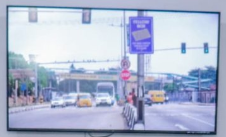By JKNewsMedia
IN THE bid to curb traffic violations and improve road safety in Lagos, the state government says it has intensified the deployment of additional Intelligent Transportation Systems (ITS) on four key routes.
The initiative is designed to enhance traffic management, enforce speed limits, and curb red-light infractions across the state.
The Lagos State Commissioner for Transportation, Oluwaseun Osiyemi, disclosed the development on Thursday at a media briefing in Alausa, Ikeja.
He stated that the new ITS infrastructure, which integrates real-time monitoring and enforcement mechanisms, will significantly improve road safety and efficiency.
The designated speed limits for the four routes include 80 kilometres per hour on Alapere-Ogudu Road and 60 kilometres per hour on Nitel, Mobolaji Bank Anthony Way, Allen Avenue Road Junction, and Nurudeen Olowopopo Road.
According to Osiyemi, violations such as running a red light or exceeding speed limits will attract fines of N20,000 and N50,000, respectively.
The newly installed ITS will complement existing Automatic Number Plate Recognition (ANPR) cameras and other Traffic Management Solution (TMS) devices, reinforcing the state’s commitment to improving road safety in the face of rapid urban expansion.

“This system is not about generating revenue but ensuring road discipline,” Osiyemi stressed. “Lagos roads must be safer, and reckless driving must be curbed.”
The ITS integrates advanced communication, control, and computer technologies into the state’s transportation framework. These solutions enable real-time traffic monitoring, ensuring precise enforcement of road regulations.
Osiyemi detailed that the ITS will be divided into two primary functions: Checkpoint Sites for Speed Detection and E-Police Sites for Monitoring Traffic Violations.
One of the Checkpoint Sites has been installed on Alapere-Ogudu Road, with a speed limit of 80 km/h, while another is located at Nitel, Mobolaji Bank Anthony Way, with a 60 km/h restriction.
These sites will focus on detecting and deterring over-speeding, a leading cause of road accidents.
The E-Police Sites, stationed at Allen Avenue Road Junction and Nurudeen Olowopopo Road, will monitor violations such as running red lights, non-compliance with lane discipline, illegal U-turns, and reversing on highways.
High-definition cameras and real-time monitoring systems will ensure traffic regulations are enforced even in the absence of physical officers.
“Enforcement begins immediately,” Osiyemi warned. “Motorists caught violating traffic laws through the ITS will receive SMS notifications from the Vehicle Inspection Service (VIS), detailing their offence and the corresponding fines.”
He highlighted the broader benefits of the ITS, including improved road safety by discouraging reckless driving, better traffic flow through real-time monitoring, and increased transparency in law enforcement by minimising human interference.
“This initiative is about saving lives, protecting property, and maintaining an orderly transportation environment,” Osiyemi added.
He urged private motorists, commercial drivers, and transport unions to comply with traffic regulations. “Stay within speed limits, obey traffic signals, maintain lane discipline, and avoid dangerous maneuvers such as reversing on major roads,” he advised.
Commissioner for Innovation, Science, and Technology, Tunbosun Alake, described the initiative as part of Lagos’ broader efforts to integrate technology into urban management. He noted that the ITS deployment aligns with the state’s commitment to leveraging innovation to enhance traffic safety and promote economic growth.
Permanent Secretary of the Ministry, Olawale Musa, emphasised that while the initiative includes fines for violations, its primary aim is behavioural change.
“This is not about punishment; it’s about fostering a culture of responsible driving,” he said. “We want Lagos roads to be safer for all.”
He adds that the expansion of the ITS marks a major step toward making Lagos a smarter, safer, and more efficient city, reinforcing Governor Babajide Sanwo-Olu’s vision for improved urban mobility and road safety.






Hello, I enjoy reading through your post. I wanted to write a little comment to support you.
Thank you. You’re appreciated.
An intriguing discussion is worth comment. I believe that you
need to write more about this subject matter, it may not be a taboo subject but generally folks don’t talk about these issues.
To the next! Best wishes!!
Howdy! I could have sworn I’ve visited this website
before but after looking at a few of the posts I realized it’s new to me.
Regardless, I’m definitely delighted I found it and I’ll be bookmarking it and checking back often!
Thanks so much for your kind words.